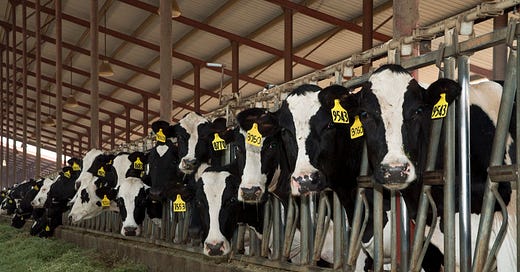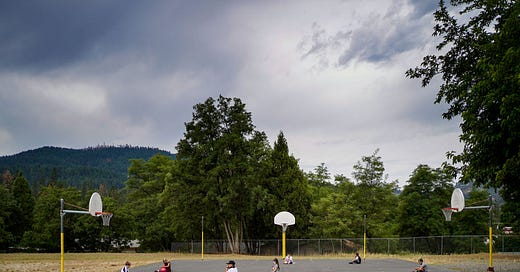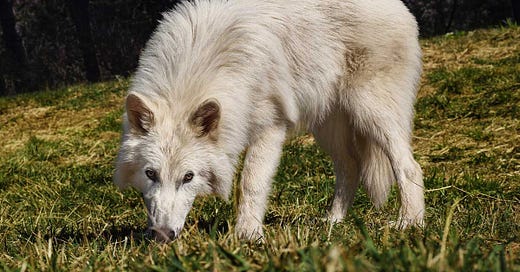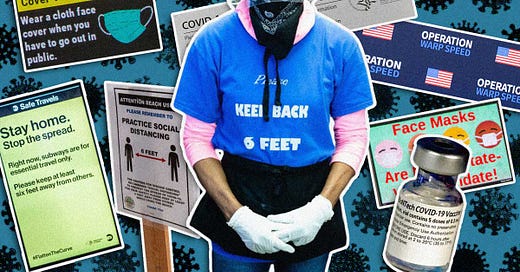
The American dairy industry is fighting a major epidemic of H5N1 avian flu right now. Cattle herds in at least eight states are infected, and 20 percent of a national sampling of milk showed fragments of the virus. Meanwhile, the public has been told to stay calm, our milk supply is safe, and nothing serious is amiss.
But we can’t be sure this is true.
Consider a recent, terrifying study on the fate of cats at a Texas dairy farm. Last week, Iowa State University researchers described what happened to 24 felines who drank raw milk and colostrum from cows teeming with the virus. They fell ill a day later, suffered “copious oculonasal discharge,” lost control of their limbs, walked in circles, became lethargic, and went blind. More than half died.
Cats are not humans—any more than canaries are coal miners—but the virus clearly went straight to their brains and killed them. That’s an ominous sign.
Meanwhile, we have been told that the virus in our cattle makes the animals only mildly ill. We have been assured that the one dairy worker, in Texas, who caught the flu from cows suffered only pinkeye. But according to the CDC case report, a real investigation, with full sampling of cows, equipment, and other workers was “not able to be conducted.” The worker did not return to the public clinic for a follow-up nor allow investigators to test his household. CBS News quoted a Texas state health official saying the worker “did not disclose the name of their workplace.” And Science magazine reported that veterinarians have seen lethargic-looking workers with pinkeye and coughs who refuse to let doctors examine them.
We’ve been repeatedly reassured that our milk supply is safe. But the FDA issued that opinion on April 23 even before it had proof that pasteurization killed the virus. Even now, we’ve seen little proof that the USDA can assure us that the millions of gallons of milk flowing through hundreds of dairy plants each day are all rendered 100 percent safe.
I am not yet fearful that H5N1 will kill millions of us. But the dairy industry and the government need to be more transparent about what is brewing inside our milk—and what’s being done to stop it.
The director of the CDC should go on television warning Americans to avoid raw milk. (One survey suggests that 4 percent of us drink it occasionally.) We need a national plan to test dairy workers who are exposed to mists of raw milk when hooking up milking machines or power-washing floors. Parents, if they are worried, could be encouraged to heat milk before giving it to their children or try oat or almondmilk, at least until this bovine epidemic is under control. (I still pour milk in my coffee, but I microwave it first. If I had young children, I would be nervous.) Finally, at a minimum, the industry should ban one of its most dangerous and disgusting practices: feeding “poultry litter”—nutrient-rich chicken feathers and feces—to cattle.
As a global health reporter, I’ve heard the same public safety assurances from governments at the beginning of every epidemic, often to protect a powerful industry. It happened in China in 2002, when SARS was covered up for months and went on to kill more than 750 people. It happened in Britain during the mad cow scandal; from 1990 to 1995, the Thatcher government insisted British beef was safe—until human deaths proved it was not. It claimed some 226 lives, according to the European CDC. And in 2016 the CDC waited two weeks before advising pregnant women to avoid cruises or flights to Latin American and Caribbean countries where the Zika virus was spreading.
No doubt the dairy industry fears alarmist headlines will kill sales, but it and our public health leaders must do more to prove the milk supply is safe. Because if one child dies of bird flu, this will be a bigger story than tents on campuses or whether or not Donald Trump can stay awake in court.
Donald G. McNeil Jr. is the author of The Wisdom of Plagues: Lessons From 25 Years of Covering Pandemics.
Become a Free Press subscriber today:














The point I take away from your story, is that even you don't trust the CDC anymore.
Bari, or whomever monitors the comments, I have a suggestion to make concerning the software. It would be very nice if I could find my comment, or the comment of some else, just by putting the name in a search box and all the comments by that person on the thread would be displayed.
I received a reply to a comment of mine, but I couldn't remember what my comment was, and I certainly did not want to spend the time to scroll through hundreds of comments to find my comment. So please, see if you can modify the software, I would not think it would be very expensive.